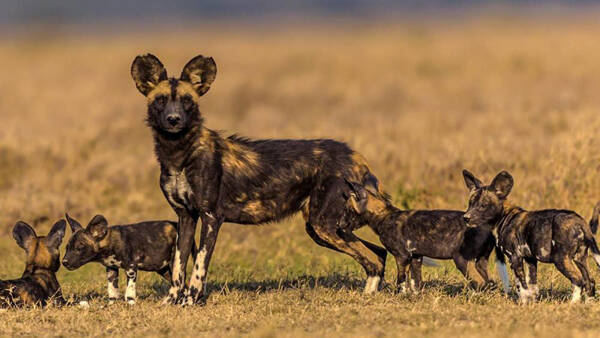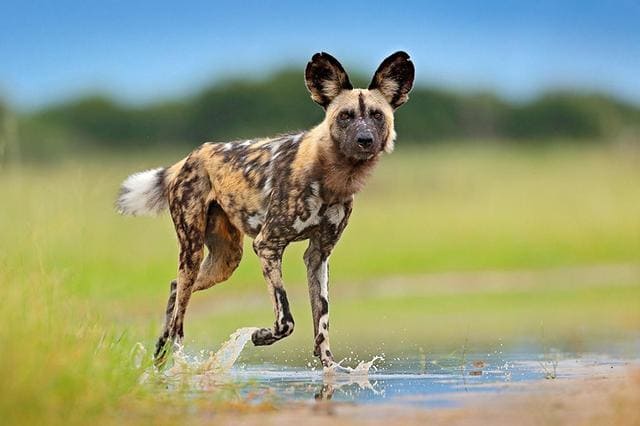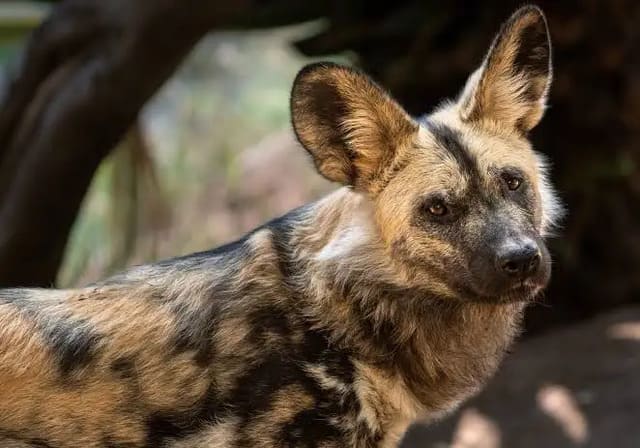African wild dog
IUCN
LCBasic Information
Scientific classification
- name:African wild dog
- Scientific Name:Lycaon pictus
- Outline:Carnivora
- Family:Schizophopoda Canidae Caninae A.W.Dog
Vital signs
- length:85-141cm
- Weight:18-34kg
- lifetime:About 10 years
Feature
The fur color is relatively messy, and the teamwork and endurance are good.
Distribution and Habitat
African wild dogs are distributed in Angola, Benin, Botswana, Burkina Faso, Central African Republic, Chad, Ethiopia, Kenya, Malawi, Mozambique, Namibia, Niger, Senegal, South Africa, Sudan, United Republic of Tanzania, Zambia, Zimbabwe.
Possibly extinct: Congo, Côte d'Ivoire, Guinea-Bissau, Mali, Nigeria, Togo, Uganda.
Regionally extinct: Burundi, Cameroon, Egypt, Eritrea, Gabon, Gambia, Ghana, Mauritania, Rwanda, Sierra Leone, Swaziland.
Mainly live in dry grasslands and semi-desert areas in Africa, active in grasslands, savannas and open dry shrubs, even including some mountainous areas in the southern part of the Sahara Desert. African wild dogs never move in dense forests.
Appearance
Adult African wild dogs weigh 18-34 kg, are 85-141 cm long, and have a tail length of 30-45 cm. There is not much difference between the sexes, with males being about 3-7% larger than females. African wild dogs in southern Africa are usually larger than those in the east and west. The color of African wild dogs is quite different from other canines. Their coat color is strange and gorgeous. Like zebras, each African wild dog has unique stripes. No two have the same color, so they can be easily distinguished by the color spots. There are areas of brown, red, black, yellow and white on their bodies, as if a painter had randomly applied the colors. Their fur is short and sparse, and some places are even bald. But generally speaking, their heads are darker in color, and there is white hair on their tails. The ears are large and round, usually standing upright on the top of the head, which is very eye-catching. The body is slender, and the long legs are well-developed with muscles, and each
Details
African wild dog, also known as Lycaon pictus, has five subspecies.

The territory of African wild dogs ranges from 200 to 2,000 square kilometers. In the past, when they were more numerous, each group had about 40 members, and the largest group ever recorded had 100 members. Generally, each group has about 7-15 adult members, and is ruled by a pair of leaders. There are often fewer females than males in the group. Most females stay in the group for their entire lives, and about half of the males do the same. The social structure and behavior patterns of these animals are very unique. They are good at cooperation and will take care of sick or injured companions, even treating them like puppies. Healthy members will give the sick and weak ones half-digested meat to eat, and nannies who take care of children will receive the same treatment. Generally speaking, African wild dog packs are peaceful, but female leaders sometimes fight with their female dogs for breeding rights.
African wild dogs hunt cooperatively, and they are led by a leader and hunt in the territory. Prey that can catch twice their body weight include antelope, wildebeest and zebra. They hunt mainly in the morning and early evening, and if the moonlight is bright, they will even be busy all night. African wild dogs hunt by sight rather than smell, and they will chase their prey closely after finding it, with a maximum speed of 55km/h, until the prey is exhausted. African wild dogs hate hyenas the most, and often kill a single hyena.
African wild dogs use a variety of different ways to communicate with each other, just like other members of the canine family, they use scent (smell), sound and posture (body language) to communicate. They have a very strong scent. It is speculated that this makes it easy to detect other group members from a distance. Unlike other canids, African wild dogs do not use urine to mark their territory except during mating season. When two wild dogs approach and touch each other, they will make a low-pitched grunt sound, and they use roars to express anger at another wild dog. Cubs make a high-pitched whine to try to get the attention of other group members.

African wild dogs are cooperative hunting animals that live in tight groups. Each group has a pair of breeding alpha dogs that mark their territory with urine. They live for about 10 years. They are led by their alpha dogs and hunt in their territory. The female alpha dogs do not allow other females in the group to reproduce, and the female African wild dogs take turns to look after the newborn puppies. Behaving much like puppies, they are generally submissive and rarely aggressive. They will lick their lips, lie back, hold their ears flat, and chatter, but not make eye contact. If they meet with bared teeth, erect tail, or a stalking posture, these are intended to ambush other wild dogs. There is no place for stalking threats in the wild dog family. If there is a physical conflict that leads to a serious fight, it is very rare. At this time, if one party tries to grab the throat of the other wild dog, the other party will scratch the ground and play dead until the other party gives up.
African wild dogs generally feed on medium-sized ungulates, such as antelope. Similar to other canines, they generally follow their prey for a long time, and can reach speeds of up to 45 miles per hour when chasing. African wild dogs in groups locate their prey by barking. After obtaining prey, they will bring it back to the den and share it with puppies, mother dogs, and other old and weak wild dogs. All African wild dogs are excellent hunters. When a pack of wild dogs chases prey, they do not rely on stealth to attack, unlike most cats. Group members use vocalization to help coordinate actions and track. The vocalization characteristics are similar to bird sounds, an unusual low roar or chirp. After a successful hunt, the well-fed wild dogs will bring the meat back and spit it out to those in the group who are guarding or feeding in the nest. This includes sick or injured wild dogs and old wild dogs that are too old to keep up with the group.
African wild dogs live in a tight group. Each group has a pair of breeding alpha dogs, which mark their territory with urine. Lifespan is about 10 years. Female alpha dogs do not allow other females in the group to reproduce, and they will even take away the pups of other female dogs. Female African wild dogs will take turns to look after newborn puppies. They can breed at any time of the year, with the peak period being the second half of the rainy season, from March to July each year. Pregnancy takes about 10 weeks, with the number of puppies per litter ranging from 2 to 20. The reproductive interval is 12 to 14 months, which can be shortened to 6 months if all the pups die. The pups are usually born in the dens of other animals (such as coyotes), and the weaning period is 10 weeks. The puppies will start to go out after 3 months. They can hunt on their own at 8 to 11 months old, and reach sexual maturity at 12 to 18 months.
Due to the large area of the African wild dog's territory, with the reduction of habitat and competition from other large carnivores, the number of African wild dogs has been declining and is already endangered. It is mainly distributed in parts of eastern and southern Africa. There are only 25 populations in 39 countries in Africa, with about 3,000 individuals. A reserve for African wild dogs has been established in Africa, mainly in the Huangri National Park in western Zimbabwe.
Due to being listed in the 2012 Red List of Endangered Species of the World Conservation Union (IUCN) ver 3.1 - Endangered (EN).
Protect wild animals and eliminate game.
Maintaining ecological balance is everyone's responsibility!











